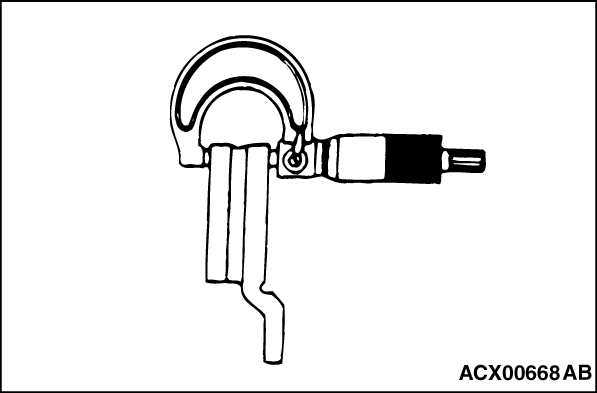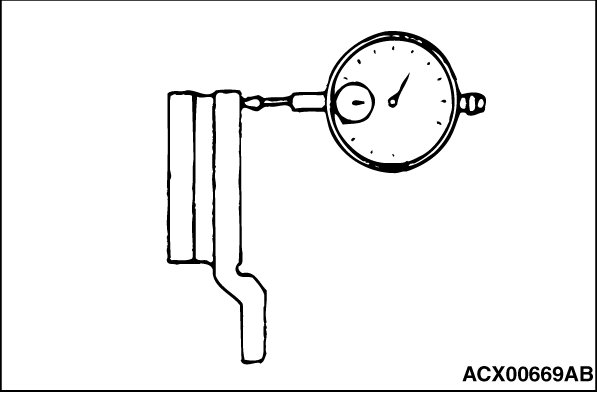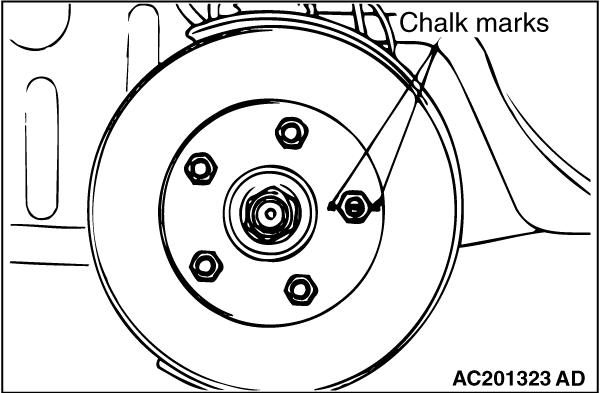Inspection item
|
Remark
|
Scratches, rust, saturated lining materials and wear
|
- If the vehicle is not driven for a long period of time,
sections of the discs that are not in contact with the pads will become rusty, causing noise and
shuddering.
- If grooves and scratches resulting from excessive disc wear are not removed prior
to installing a new pad assembly, there will be inadequate contact between the disc and the
lining (pad) until the pads conform to the disc.
|
Run-out
|
Excessive run-out of the discs will increase the pedal depression
resistance due to piston kick-back.
|
Change in thickness (parallelism)
|
If the thickness of the disc changes, this will cause pedal pulsation,
shuddering and surging.
|
Inset or warping (flatness)
|
Overheating and improper handling while servicing will cause warping
or distortion.
|

|
1.Using a micrometer, measure disc thickness at eight positions, approximately 45 degrees
apart and 10 mm (0.4 inch) in from the outer edge of the disc.
Standard value:
26.0 mm (1.02 inches) <Front (Except RALLIART)>
24.0 mm (0.94 inch) <Front (RALLIART)>
10.0 mm (0.39 inch) <Rear>
Limit:
24.4 mm (0.96 inch) <Front (Except RALLIART)>
22.4 mm (0.88 inch) <Front (RALLIART)>
8.4 mm (0.33 inch) <Rear>
| note |
Thickness variation (at least 8 positions) should not be more than 0.015 mm (0.0006 inch).
|
|

|
2.
| caution |
- After a new brake disc
is installed, always grind the brake disc with on-the-car type brake lathe.If this step is not
carried out, the brake disc run-out exceeds the specified value, resulting in judder.
- When the on-the-car type lathe is used, first install M12 flat washer on the stud bolt
in the brake disc side according to the figure, and then install the adapter. If the adapter
is installed with M12 flat washer not seated, the brake disc rotor may be deformed, resulting
in inaccurate grinding.
- Grind the brake disc with all wheel nuts diagonally and equally tightened to the
specified torque 100 N·m (74 ft-lb). When all numbers of wheel nuts are not used, or
the tightening torque is excessive or not equal, the brake disc rotor or drum may be deformed,
resulting in judder.
|
If the disc thickness is less than the limits, replace it with a new one. If thickness
variation exceeds the specification, turn rotor with an on-the-car type brake lathe ("MAD, DL-8700PF"
or equivalent). If the calculated final thickness after turning the rotor is less than the standard
value, replace the disc.
|
|
|
1.Remove the brake assembly, and then hold it with wire.
|
|
|
2.Temporarily install the disc with the hub nut.
|

|
3.Place a dial gauge approximately 5 mm (0.2 inch) from the outer circumference of the brake
disc, and measure the run-out of the disc.
Limit:
0.06 mm (0.0024 inch) <Front>
0.08 mm (0.0032 inch) <Rear>
|

|
4.When the run-out exceeds the limit value, correct the brake disc run-out in the following
procedure.
(1)
Before removing the brake disc, mark the stud bolt on the side of greater run-out and
its both sides with a chalk.
(2)
Check for wheel bearing looseness in the axial direction (Refer to GROUP 26 - On-vehicle
Service, Wheel bearing play check  <Front>,
GROUP 27A - On-vehicle Service, Wheel bearing end play check <Front>,
GROUP 27A - On-vehicle Service, Wheel bearing end play check  <Rear
(FWD)> or GROUP 27B - On-vehicle Service, Wheel bearing end play check <Rear
(FWD)> or GROUP 27B - On-vehicle Service, Wheel bearing end play check  <Rear
(AWD)>). <Rear
(AWD)>).
(3)
When the looseness is within the limit value, install the brake disc after changing
the phase between the hub and the brake disc, then check the run-out of the brake disc again.
|

|
5.
| caution |
- After a new brake disc is installed, always
grind the brake disc with on-the-car type brake lathe. If this step is not carried out, the
brake disc run-out exceeds the specified value, resulting in judder.
- When the on-the-car type lathe is used, first install M12 flat washer on the stud bolt
in the brake disc side according to the figure, and then install the adapter. If the adapter
is installed with M12 flat washer not seated, the brake disc rotor may be deformed, resulting
in inaccurate grinding.
- Grind the brake disc with all wheel nuts diagonally and equally tightened to the
specified torque 100 N·m (74 ft-lb). When all numbers of wheel nuts are not used, or
the tightening torque is excessive or not equal, the brake disc rotor or drum may be deformed,
resulting in judder.
|
If the run-out cannot be corrected by changing the phase of the brake disc, replace the
brake disc or grind it with the on-the-car type brake lathe ("MAD, DL-8700PF" or equivalent).
|

![[Previous]](../../../buttons/fprev.png)
![[Next]](../../../buttons/fnext.png)



